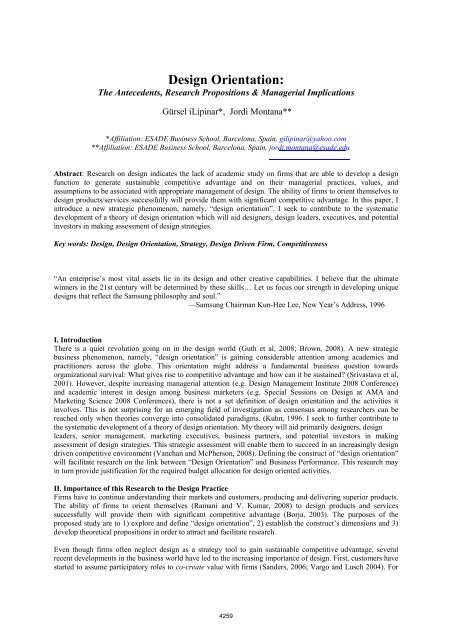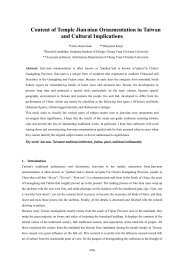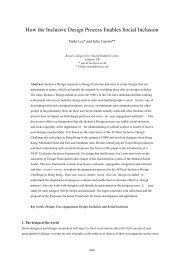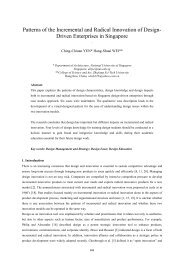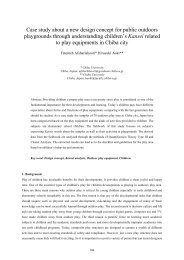Design Orientation: The Antecedents, Research ... - iasdr 2009
Design Orientation: The Antecedents, Research ... - iasdr 2009
Design Orientation: The Antecedents, Research ... - iasdr 2009
Create successful ePaper yourself
Turn your PDF publications into a flip-book with our unique Google optimized e-Paper software.
<strong>Design</strong> <strong>Orientation</strong>:<br />
<strong>The</strong> <strong>Antecedents</strong>, <strong>Research</strong> Propositions & Managerial Implications<br />
Gürsel iLipinar*, Jordi Montana**<br />
*Affiliation: ESADE Business School, Barcelona, Spain, gilipinar@yahoo.com<br />
**Affiliation: ESADE Business School, Barcelona, Spain, jordi.montana@esade.edu<br />
Abstract: <strong>Research</strong> on design indicates the lack of academic study on firms that are able to develop a design<br />
function to generate sustainable competitive advantage and on their managerial practices, values, and<br />
assumptions to be associated with appropriate management of design. <strong>The</strong> ability of firms to orient themselves to<br />
design products/services successfully will provide them with significant competitive advantage. In this paper, I<br />
introduce a new strategic phenomenon, namely, “design orientation”. I seek to contribute to the systematic<br />
development of a theory of design orientation which will aid designers, design leaders, executives, and potential<br />
investors in making assessment of design strategies.<br />
Key words: <strong>Design</strong>, <strong>Design</strong> <strong>Orientation</strong>, Strategy, <strong>Design</strong> Driven Firm, Competitiveness<br />
“An enterprise’s most vital assets lie in its design and other creative capabilities. I believe that the ultimate<br />
winners in the 21st century will be determined by these skills… Let us focus our strength in developing unique<br />
designs that reflect the Samsung philosophy and soul.”<br />
—Samsung Chairman Kun-Hee Lee, New Year’s Address, 1996<br />
I. Introduction<br />
<strong>The</strong>re is a quiet revolution going on in the design world (Guth et al, 2008; Brown, 2008). A new strategic<br />
business phenomenon, namely, “design orientation” is gaining considerable attention among academics and<br />
practitioners across the globe. This orientation might address a fundamental business question towards<br />
organizational survival: What gives rise to competitive advantage and how can it be sustained? (Srivastava et al,<br />
2001). However, despite increasing managerial attention (e.g. <strong>Design</strong> Management Institute 2008 Conference)<br />
and academic interest in design among business marketers (e.g. Special Sessions on <strong>Design</strong> at AMA and<br />
Marketing Science 2008 Conferences), there is not a set definition of design orientation and the activities it<br />
involves. This is not surprising for an emerging field of investigation as consensus among researchers can be<br />
reached only when theories converge into consolidated paradigms. (Kuhn, 1996. I seek to further contribute to<br />
the systematic development of a theory of design orientation. My theory will aid primarily designers, design<br />
leaders, senior management, marketing executives, business partners, and potential investors in making<br />
assessment of design strategies. This strategic assessment will enable them to succeed in an increasingly design<br />
driven competitive environment (Vanchan and McPherson, 2008). Defining the construct of “design orientation”<br />
will facilitate research on the link between “<strong>Design</strong> <strong>Orientation</strong>” and Business Performance. This research may<br />
in turn provide justification for the required budget allocation for design oriented activities.<br />
II. Importance of this <strong>Research</strong> to the <strong>Design</strong> Practice<br />
Firms have to continue understanding their markets and customers, producing and delivering superior products.<br />
<strong>The</strong> ability of firms to orient themselves (Ramani and V. Kumar, 2008) to design products and services<br />
successfully will provide them with significant competitive advantage (Borja, 2003). <strong>The</strong> purposes of the<br />
proposed study are to 1) explore and define “design orientation”, 2) establish the construct’s dimensions and 3)<br />
develop theoretical propositions in order to attract and facilitate research.<br />
Even though firms often neglect design as a strategy tool to gain sustainable competitive advantage, several<br />
recent developments in the business world have led to the increasing importance of design. First, customers have<br />
started to assume participatory roles to co-create value with firms (Sanders, 2006; Vargo and Lusch 2004). For<br />
4259
example, Nike designs products to help consumers engage more fully in the running process and achieve their<br />
running-related goals: smart shoes that track performance and inform runners when they have broken their<br />
personal records (Ramaswamy, 2008). Second, due to intense competition, product performance and price<br />
became less important differentiators. In this new environment, suppliers search for new avenues to differentiate<br />
themselves (Ulaga and Eggert, 2006).<br />
In spite of the fact that product appearance would not seem to be superior to performance, Yamamoto and<br />
Lambert (1994) provide evidence that the appearance of an industrial product may have an impact on its<br />
evaluation. <strong>The</strong> authors show that aesthetic industrial product imposes an influence, which in some<br />
circumstances exceeds the influence of certain product functionality or price attributes. <strong>The</strong>y maintain that the<br />
impact of product appearance affects people in different organizational functions, across a range of technical<br />
orientations (Yamamoto and Lambert, 1994). Acknowledging the importance of other product characteristics,<br />
Orth and Malkewitz’s research on packaging (2008) emphasize the design elements, such as the hourglass shape<br />
of the Coca-Cola bottle and its logo in Spencerian type or the round-shouldered Bordeaux-style wine bottles<br />
(Orth and Malkewitz, 2008). <strong>The</strong> authors (2008) indicate that design elements create a package’s visual<br />
appearance and they become an integral part of a brand’s image. Moreover, Justice (2008) asserts that marketing<br />
and engineering are the primary drivers of innovation. However, what makes satisfy a desire or a need is the<br />
emotional aspect of product “lust”. <strong>The</strong> critical role of the designer is to combine the usability and aesthetics<br />
concepts to achieve a great product by acknowledging the importance of ‘designing for emotion’ (Justice, 2008;<br />
Norman, 2004). Below, Apple demonstrates one of the best examples of how a design driven company can use<br />
design thinking to obtain a sustainable competitive advantage by influencing the consumer behavior through<br />
altering not only the means of distribution but even the ways in which people enjoy and think about music<br />
(Levy, 2006).<br />
IV. <strong>The</strong> <strong>The</strong>oretical Contributions of this <strong>Research</strong><br />
<strong>The</strong> design literature has a particular interest in design’s effect on business performance (Borja, 2007). However,<br />
there is little research done (Gotzsch, 1998) on developing a framework of "<strong>Design</strong> <strong>Orientation</strong>". <strong>The</strong> anecdotal<br />
evidence which lacks clear and comprehensive construct in the literature that captures the key elements of a<br />
design orientation, motivates me to study to address this gap by synthesizing extant knowledge on the subject.<br />
My research also aims to provide a foundation for operationalization of design orientation through establishing<br />
the construct's domain, developing research propositions, and constructing an integrating framework that<br />
includes determinants of a “<strong>Design</strong> <strong>Orientation</strong>”.<br />
V. Purpose of the <strong>Research</strong><br />
<strong>The</strong> proposed research will identify and analyze the nature of a newly emergent construct of “design<br />
orientation”. More specifically, it will develop an understanding of why some firms are more design-oriented<br />
than others and what the role of design in co-creation environment (the inclusion of B2B customer and consumer<br />
into the design process) could be. In particular, my research will: Define the construct of <strong>Design</strong> <strong>Orientation</strong> in a<br />
B2B/B2C setting; Identify the underlying dimensions of <strong>Design</strong> <strong>Orientation</strong>. Specifically it will address the<br />
4260
following questions: What kinds of activities does a <strong>Design</strong>-Oriented company do? What previously<br />
unacknowledged factors influence and are influenced by <strong>Design</strong> <strong>Orientation</strong>? And finally it will develop<br />
research propositions to be tested, and construct an integrating framework that includes antecedents of <strong>Design</strong><br />
<strong>Orientation</strong>.<br />
VI. <strong>Research</strong> Methodology<br />
Given the nature of the objectives as developing understanding (Dyson et al, 1996, 1997) from the responses of<br />
people and organizations of the “<strong>Design</strong> <strong>Orientation</strong>” phenomena, I propose a discovery-oriented, theories-in-use<br />
approach (e.g.Tuli, Kohli and Bharadwaj, 2007). Because the purpose of the study is to uncover what design<br />
orientation means and to develop a taxonomy towards a generalizable theory, it is important to include a wide<br />
range of experiences and perspectives in the course of the data collection (Corbin and Strauss, 2008). <strong>The</strong>refore,<br />
I will use a “theoretical” sampling plan to interview managers across functions and hierarchal levels in multiple<br />
industries including large and medium size companies. <strong>The</strong> sample will be a combination of firms selected from<br />
Businessweek’s “<strong>The</strong> World’s Most Innovative Companies” list (e.g. Coca Cola, BMW, Target, Nike,<br />
Electrolux, Apple, 3M, etc.), their main distributors, and contacts obtained from professional design associations<br />
(Industrial <strong>Design</strong> Society of America (IDSA), and American Institute for Graphic Arts (AIGA)). <strong>The</strong> data<br />
analysis will follow the general procedures of basic qualitative research to allow the interplay of data and<br />
researcher via inductive and deductive process (Corbin and Strauss, 2008). <strong>The</strong> scope of this study will be<br />
limited to firms which manufacture primarily tangible products. However, the interviews will capture the<br />
statements related to all kinds of design to find evidence towards design orientation in a broader sense (i.e. web<br />
design, service design, store design, workspace design, communication design, graphic design, etc.).<br />
VII. Conclusion<br />
Based on the initial analysis of the first 10 interviews with senior managers from large corporations and<br />
designers from leading design firms, it is too early to begin developing research propositions. However, as<br />
antecedents towards determining the dimensions of the construct of “<strong>Design</strong> <strong>Orientation</strong>” several themes already<br />
began to emerge. <strong>The</strong>se emerging themes are willingness to take a risk with design firm, authenticity, senior<br />
management commitment, emphasis on design-training, etc. So far my interviews indicate that most of the<br />
<strong>Design</strong> executives still report to VP of Marketing. This creates a conflict for the <strong>Design</strong> executives as they feel<br />
that their ideas are filtered by the VP of Marketing. According to the preliminary results, one of the biggest<br />
challenges for the the <strong>Design</strong> executives is having direct reporting relationship to the CEO of their company. So<br />
I observe that the higher the <strong>Design</strong> executive is in the organizational chart, the more <strong>Design</strong> Oriented the<br />
company is.<br />
References:<br />
[1] Borja de Mozota, Brigitte, 2003, <strong>Design</strong> Management: Using <strong>Design</strong> to Build Brand Value and Corporate<br />
Innovation, New York, Allworth Press.<br />
[2] Brown, Tim, <strong>Design</strong> Thinking. Harvard Business Review, June 2008<br />
[3] Dyson, Paul; Farr, Andy; and Hollis, Nigel, “What Does the Marketing Team Need, Description or<br />
Prescription? Journal of Advertising <strong>Research</strong>, Vol. 37, No. 1, January/February 1997<br />
[4] Glaser Barney G. and Strauss Anselm L. 1967. <strong>The</strong> Discovery of Grounded <strong>The</strong>ory, Chicago: Aldine.<br />
[5] Guth, Robert A., Scheck, J. and Clark, D., <strong>Design</strong>ers Rule at Dell, Wall Street Journal, January 4, 2008,<br />
[6] Gotzsch, J,1998, Managing New Product Innovation, Proceedings of the Conference of <strong>Design</strong> <strong>Research</strong><br />
Society, London, Taylor and Francis.<br />
[7] Hertenstein, Platt and Veryzer, <strong>The</strong> Impact of Industrial <strong>Design</strong> Effectiveness on Corporate Financial<br />
Performance. Journal of Product Innovation Management, Jan2005, Vol. 22 Issue 1, p3-21,<br />
[8] Justice, Lorraine, http://www.design-emotion.com/2008/05/19/getting-emotional-with-lorraine-justice/, 2008<br />
[9] Kohli, Ajay K., Jaworski, Bernard J., Market <strong>Orientation</strong>: <strong>The</strong> Construct, <strong>Research</strong> Propositions, and<br />
Managerial Implications. Journal of Marketing, Apr90, Vol. 54 Issue 2, p1-18, 18p<br />
4261
[10] Kuhn T.S. 1996. <strong>The</strong> Structure of Scientific Revolutions (3rd edn), Chicago, IL: University of Chicago<br />
Press.<br />
[11] Norman, Donald A., 2004, Emotional <strong>Design</strong>, Cambridge, MA, Basic Books<br />
[12] Levy, Steven, 2006. <strong>The</strong> Perfect Thing: How the iPod Shuffles Commerce, Culture, and Coolness, NY, NY:<br />
Simon and Schuster<br />
[13] Orth, Ulrich R. & Malkewitz, Keven, Holistic Package <strong>Design</strong> and Consumer Brand Impressions. Journal of<br />
Marketing, May 2008, Vol. 72, p64-81<br />
[14] Postrel, Virginia, 2003, Substance of Style, Harper Collins Publishers; Pub 256pp;<br />
[15] Ramani, G. and V. Kumar (2008), “Interaction <strong>Orientation</strong> & Firm Performance”, Journal of Marketing,<br />
Vol 72 (1), January, pp 27-45.<br />
[16] Ramaswamy, Venkat, 2008, MSI Conference on Innovation and Co-creation (June 2008)<br />
[17] Sanders, Elizabeth, 2006, <strong>Design</strong> <strong>Research</strong> in 2006, <strong>Design</strong> <strong>Research</strong> Quarterly, V. I:1 September 2006<br />
[18] Srivastava, Rajendra, Liam Fahey and Kurt Christianson (2001) “Resource-Based View and Marketing”<br />
Journal of Management, 27, 777-802, (Special Issue on Resource-Based View Retrospectives).<br />
[19] Strauss, A. L. & Corbin J. Grounded theory methodology. In. Handbook of qualitative research. Thousand<br />
Oaks, CA: Sage; 1994; pp. 273-285.<br />
[20] Styhre, Alexander (2001), Nomadic Organization: <strong>The</strong> postmodern organization of becoming, Journal of<br />
Critical Postmodern Organization Science.<br />
[21] Ulaga, W.; Eggert, A. (2006). Value-Based Differentiation in Business Relationships: Gaining and<br />
Sustaining Key Supplier Status. In: Journal of Marketing, Vol. 70, No. 1, pp. 119-136.<br />
[22] Vanchan, Vida and McPherson, Alan, 2008, <strong>The</strong> Competitive Characteristics of US Firms in the Industrial<br />
<strong>Design</strong> Sector in Competition and Change,<br />
[23] Yamamoto M. and Lambert D.R. 1994. <strong>The</strong> impact of product aesthetics on the evaluation of industrial<br />
products, Journal of Product Innovation Management, 11(29): 309-324.<br />
[24] Zaltman, Gerald, LeMasters, Karen and Heffring, Michael (1982), <strong>The</strong>ory Construction in Marketing. New<br />
York: John Wiley & Sons, Inc.<br />
4262


